
THE NORSEMAN’S DIARIES
Fall Edition Canceled
and
Another Brief History of Climate
by Jeff Fullerton
[email protected]
Attribute to L. Neil Smith’s The Libertarian Enterprise
First & last entry for 2018:
New Year's Eve going into 2019
The year is almost finished and the weather has turned decidedly milder after a mostly blah and chilly fall that at times felt a lot like January.
Luckily; Crunch Time that was in progress in the latter entries of the previous installment played out relatively smoothly and is now behind me. Along with the Thanksgiving holiday and Tax Freedom day in regard to the last installment of the fall school property taxes. So I'm now looking forward to maybe some smoother sailing and the start of winter projects as I slowly sort things out after the hasty retreat of moving fish , critters and plants out of harm's way. It went much better this time around and maybe I should do a brief recap instead of a full narrative of the Diaries—as Fall—if you could even call it that—was a very short loved affair—if we even had one at all.
The Fall Edition for 2018 was more or less canceled along with Indian Summer. This unsettling trend began shortly after I finished pulling in the Green Swordtails in mid October with a sharp cool down and then a series of cold outbreaks that came in fits and starts and between the pulses I began gathering up the outside turtles which were in the process of digging in and got them into their wintering crates (for the terrestrial species) and sweater box containers (for the aquatics).
And I worked on getting the ponds ready for winter starting off with the one in the greenhouse which I drained and cleaned again in preparation for receiving the larger catfish and Redbreasted Sunfishes. Then the smaller outside ponds and tubs saving the 20 x 16 foot main pond for last. That all went well and I even got a decent harvest of YOY (young of the year) from both the Redbreasts and Marbled Bullheads and traded some of the later for some YOY Blackbanded Sunfish to add some new blood to my current population that I hope to get going again in the coming years.
Like so many other things I struggle with including this edition of the diaries which I decided to go forward with in the condensed version because the time is too short to put something together from the material on hand. I tried but is just not working out. What I need to do is keep an actual diary and write down the really significant events rather than gleaning them from a couple months or so of email correspondence. There were a few more of such.
Another issue with the greenhouse heating system. The thermostat was off by several degrees but I managed to tweak it to come on at the desired temp of 50 degrees as a stopgap measure so I could put off installing a new one until maybe a better time from both a physical and financial perspective. And there were more husbandry problems with the Marsupial Frogs and and the tank with the new Blackbandeds crashed just this week and I will detail those in a later issue when I have more time. Those were the worst things to happen in this particular Crunch. For the most part I've managed to get out in front of the problems that overtook me last winter and am working toward reclaiming lost ground and taking the crunch out of future Crunches!
So it is now coming up on the end of December and Norseman's Hell continues its onslaught of deep penetrations into the Southland—much like it did last year alternating with mild periods of west to east zonal flow—courtesy of an El Niño they say. If the latter trend hangs on I'm not going to complain and I really hope it does because it make life a lot less difficult and dangerous as the guy in this YouTube video concurs with his disdain for people who whine about the lack of snow.
https://m.youtube.com/watch?v=p7PYZzYGJjg
Many of Ray's emails read like this when he's ticked off about the Yankee winter lovers. Which is usually all year long since it seems when they are not complaining about the lack of snow they are complaining about it being a few degrees above normal during the warmer months.
Now for Another Brief History of Climate.
Or maybe not so brief.
With all the polemic rhetoric being spewed about climate change you have to wonder; what is normal or even what exactly is an optimal climate? My guess: if you are a climate change alarmist with a left wing ideology—“normal” or “optimal” probably means the relatively benign conditions of recent history in this current interglacial period—which has had it's share of crazy weather and climate shifts—some of which were anything but optimal to life or civilization. And there is consensus even among the climate skeptics who argue against anthropogenic global warming that we may be nearing the end of a brief period of benign climate that fostered the rise of our civilization. However there is yet another somewhat radical alternate view. What if this current state of climate we are in is actually the least optimal regime between two opposite yet more benign states? Like the stability of a glacial maximum and the stability of a peak interglacial?
I got this idea when I discovered an article on the Paleoclimatic Implications of Pleistocene Herpetofaunas of Eastern and Central North America by J. Alan Holman—a paleoecologist who specialized in herpetology and published this and some other interesting papers in the 1960s.
https://digitalcommons.unl.edu/cgi/viewcontent.cgi?article=1285&context=tnas
Holman's conclusions on the climate of several glacials including the late Wisconsin Ice Age was that conditions were cooler than normal in the Appalachians and Ozark region but milder overall in much of the south and central lowlands—warmer in winter and cooler in summer.
It was apparently a pretty decent climate for reptiles in spite of the glaciers covering the land a few hundred miles to the north. There were Geochelone tortoises in Texas, Kansas and north Georgia coexisting with North American Wood and Blandings turtles and giant box turtles which were probably Terrepene putnami that may be the Pleistocene ancestors of the modern Gulf Coast and Yucatan box turtles. I'm wondering if the tortoises referred to as ”Geochelone” might not be some form of Gopherus—like the Gopher and Desert Tortoises—or the Bolson's Tortoises from Mexico? Geochelone used to be a catch all for all tortoises before the splitters did their thing and that article is from older literature.
I also remember the Cumberland Cave assemblage mentioned in the article from something I stumbled across researching old herpetological journals in the Library of Congress years ago. Fox Snakes in western Maryland seemed a bit weird at the time but combined with geological evidence for extensive ponding of glacial lakes all over western Pennsylvania and the adjoining states it starts to make sense. As well as the relict populations of Redside and Pearl Dace and several other upper Midwestern species. And a mixed up flora with relict populations of northern and southern plants.
All this is evidence of a milder Ice Age climate with temperate forests once you get away from the ice front and shoots the notion of subarctic semi desert conditions going all the way into the Deep South supposed by some paleo climatologists to hell and back. You couldn't have large tortoises living there at the time if it were like that. And Eastern box turtles would have had a hard time repopulating as far north as they exist today. 10,000 years may not be time enough for such a slow moving species with strong fidelity to small home ranges to reach the current limit of the range which is fairly close to the terminal moraine in northern Pennsylvania. The average box turtle spends its lifetime in an area about the size of a football field.
This suggests they may have been here the whole time or did not loose that much ground during the glacial maximum.
It would be pretty neat if you could take a trip back through time and
live here about 900,000 years ago. That's long before the paleo Indians got
here—indeed it might even be close to the time archaic humans still shared
the planet with Homo erectus. You could sail all over western Pennsylvania
on the maze of coves and islands of Glacial Lake Monogehela
https://en.m.wikipedia.org/wiki/Lake_Monongahela
It would be quite an adventure and maybe not a bad place to settle down if you could bring some advanced technology along live a high tech hunter gatherer lifestyle. Bag a mammoth and put up a year's supply of meat for your walk in freezer powered by a mini atomic reactor!
Flights of SF fancy aside I'll postulate that the climate at the time here would be favorable to human life as it was to animals that would be hard pressed to survive under modern conditions let alone a climate like Alaska. It could be that the cold air over the great continental glacier squeezed the jet streams to the south and created a more permanent zonal west to east flow that brought milder pacific air across North America nearly all the time instead of that constant seesaw of polar vortices and subtropical air masses and El Niños and La Niñas that make our climate and weather today so volatile? That would explain the fossil evidence of unusual mixes of warm and cooler climate flora and fauna coexisting during the Ice Age in places that many climatologists were saying had harsh arctic or desert conditions.
Since life thrived during glacial times as well as during the warmer climate before the glaciers I wonder if the so called happy medium of what we have today is the less ideal world? Mainly because its just so unstable and disruptive.
Now that sounds crazy, doesn't it? But so does the idea of tortoises living somewhere that ought to be boreal forest or tundra.
I've heard that: cold air was spilling off the glaciers, chilling the climate and triggering violent storms and there is evidence that it was colder here based on polygon formations of rocks on Mt Davis (the highest point in the state) but considering the distribution patterns of certain fishes in glaciated areas—I'm convinced glacial lake networks facilitated their dispersal which means these lakes had to be warmer than your run of the mill alpine or arctic lake. Much of the water going into them was sourced from lands south of the glaciers flowing northward so this Idea has merit.
It would probably be cold near the ice front but these glacial lake megaplexes extended up to 100 miles or more away. Lake Monongahela extended down into central West Virginia and surely had lots of shallow coves and marshes that warmed up in the summer. Had to be the same with Lake Tight in the former Teays drainage in southern Ohio and Lake Wisconsin which all left a footprints in the way of relict populations of a fish fauna more common in the glaciated territories of the Great Lakes region. Those glacial lakes were probably full of brook trout , Redside and Northern Redbelly Dace and a lot of other fish typical of glacial pothole lakes and wetlands all across the upper Midwest and New England.
It is possible the cold air over the glaciers could have influenced the climate in close proximity to the glaciers and in higher altitudes of the southern Appalachians—which would facilitate the establishment of relict populations of northern plants in alpine zones that persisted after the glacial retreat. More important would be the squeezing of the jet stream that might eliminate the fluctuating undulations and dips typical of the modern climate in favor of a west to east zonal flow. Like having a permanent El Niño which makes for milder winters and summers rather than extreme cold and heat. You get less continentality and a more maritime climate like the Pacific Northwest or England—or in the case of an interglacial: a warmer planet with higher sea levels and smaller land mass.
Of course I say maritime climate and that conjures up visions of perpetual cloudiness and gloom with a short and lousy growing season for most crops. Like London or Seattle. Maybe so—though even in those places it doesn't rain all the time and there are still sunny days. The zonal flow would make the summers moist and mild and winters less severe. Even with increased cloudiness England and the west coast of North America are actually great places to be a horticulturalist. There are scores of plants they can grow that can't handle our summers or winters. It's temperature more than light that is the limiting factor for plants. Isaac Arthur says you can still get decent growth even out in the Asteroid Belt—2 to 3 AU from the sun because plants only use a fraction of the visible spectrum you get here at 1 AU on Earth.
https://m.youtube.com/watch?v=0ENabNTQwNg&vl=en
Life has endured on this planet for billions of years. What it prefers is warmth and stability. Most mass extinctions happen from traumatic shocks to the system like asteroid impacts and super volcanic events or astrophysical catastrophes like supernovae or gamma ray bursts. And to a lesser degree from climate change during the transitional phases between stages—ie glacials and interglacials. That causes more severe weather too. You'll get that whenever its warming or cooling until you reach the new equilibrium and things settle down. Happens also on a warmer earth—you get temperate flora in Greenland and a wet Sahara. Or dinosaurs living near the poles—and everywhere else because with higher sea levels and less land mass you get rid of the desert belts and increased evaporation leads to more cloud cover that keeps the equatorial regions from overheating. Most of the planet may have been like Hawaii and the polar regions like South Carolina with cold winters above the arctic circle during the time it was dark. The dinosaurs being warm blooded could adapt to that and evidence is emerging that those populations had feathers covering their bodies to insulate like mammals use fur. And the plants adapted by dropping leaves or dying back into the ground during the dark winter period. Like most modern broadleaf trees and deciduous conifers such as bald cypress and dawn redwood. And herbaceous perennials. Our modern temperate flora acquired its current character as it developed in the lands of the far north in the mid to late Cretaceous Age going into the warmer early Cenozoic. That prepared it for dominating the modern world as it spread across the northern hemisphere—the Acro-Tertiary Geoflora colonized southward as the planet cooled going into later Cenozoic times and persisted as remnants in Eurasia and North America after the original source was obliterated by continental glaciation.
Noting the obvious connections between the floras and faunas of the northern continents we can only wonder what must have been in Canada before the Pleistocene. I'll bet the great Teays River of Pliocene times was the great conveyor of temperate flora and fauna from the north country as it flowed on a northwesterly course—probably to the St Lawrence drainage or the upper Mississippi .
https://en.m.wikipedia.org/wiki/Teays_River
They say the Teays was a biodiversity hotspot for freshwater fishes like a temperate zone Amazon and it was the source from which the modern fish fauna of the central US and northeast derived. Because it could be colonized from north to south by fishes swimming toward the headwaters and transfers of species to adjoining drainage systems via stream captures—it made for an excellent glacial refugium and dispersal mechanism to save many taxa that would otherwise have been lost—even while it was being destroyed by ice damming and erosion of glacial lake outlets that obliterated it by altering and creating new drainage patterns.
The thing that created this whole setup may have been decreasing of the axial tilt that is considered a cyclical factor in triggering ice ages by many paleoclimatologists. Cooler tropics and warmer poles that allow more snow at higher latitudes that doesn't melt off in the summer. Combine that with an extended cycle of weaker solar activity and you get a glacial. High latitudes buried under ice and mild temperate zones that allow both northern and subtropical species to coexist in the same biomes. The idea I've put forth is that it's not the glacial or interglacial periods that are hostile to life but the transitional stages like what we've been in since the last climatic optimum. With more instability of climate you get extreme weather and more species extinctions. With stability during glacials you have reptiles and temperature forests living in closer proximity to glaciers. With stability in an interglacial you get northward migration of species and a wet Sahara. With instability between either equilibrium you get cold snaps like the Younger Dryas and expansion of deserts.
As for Ray's current woes; Wisconsin is just in a bad place. It's inland on large land mass so it gets the brunt of both brutal winters and summer droughts even when it's not buried under an ice sheet. And it also lucks out on the oscillation of the jet streams and moderating effects of the El Niño effect zonal flow most of the time!
Saturday 1/12/19
Postscript:
Coming up on the middle of the month already which is a good sign that—I hope—the winter will pass quickly at least in terms of subjective time and severity.
Last week may have been the end of the milder weather which made parts of December and the beginning half of January at times nicer than November. It's always nice to have a good January thaw to run out the clock while the sun angle is low keeping the the frigid blasts of the Polar Vortices and Alberta Clippers at bay for a while. Sadly it looks as if the El Niño may be coming to an end as the last of the 50 and 60 degree days happened early in the week and I was too debilitated from a back injury to enjoy let alone make use of it.
I was in my garage Monday evening checking out the turts in the old chest freezer that is their hibernaculum when I closed the lid and turned away and was smitten with excruciating pain in my lower back that happens time to time because of a chronic sciatica problem aggravated by arthritis. Ended up missing a day of work because of it and the downtime I was planning to put to good use in reclaiming the Florida Room that was my indoor winter paradise in the years before the greenhouse was raised. Recovery has been slow but I managed to get back on my feet having a day off plus half a day to recover enough to to work the two remaining shifts of the week and I may be well enough to work this weekend on reconfiguring the present arrangement of tanks and cages that displaced the Turtle Table from the back corner of the room that was a focal point for an impressive display of tropical plants and a 55 gallon vivarium that housed a trio of Red-eyed Tree Frogs.
The plan is to make this setup a cornerstone of my ongoing operations that will also involve other restorations of the pond and the greenhouse to the former glories of their early days right after they were finished in the 1990s and early 2000s.
I will be detailing plans and progress on these projects in the long overdue sequel to my last Nihon Ishigame article and future editions of the diaries as things unfold. It makes for an uplifting experience already; going through boxes of old photos from those glory days of three or four distinct epochs in my hobbyist pursuits sorting out the best of each one and looking to combine it all into a smooth , harmonious operation using the pictures as a guide for restoration.
However this is tempered by the uncertain prospects of weather, financial, physical and time restraints and more disturbingly; the people currently drumbeating about a Green New Deal that is for the most part a rehash of the old New Deal and the World War II rationing and command economy. And if it were not bad enough coming from the newly elected cohort of Alexandria Ocasio Cortez in Washington: we now have the reelected governor of Pennsylvania calling for the same at the state level. Possible grim implications for running my house let alone the greenhouse and an artificially lit growing area in the basement if in the words of former President Obama: our “utility rates will necessarily skyrocket” under the ambitious California style commitment to cut carbon emissions in the coming decades.
Ironic that now I'm more worried about the future with Donald Trump in office than I was in the latter years of Bill Clinton with the dark predictions of disruptions and government power grabs in the forecast to deal with the looming Y2K problem—or aftermath of 9/11 or the early days of Obama. The days of the Trump Administration have so far been much more freedom and economically friendly as reflected in the blanket ban on the interstate transport of salamanders and newts imposed by the Fish & Wildlife Service that was allowed to expire and in lower energy costs that make it less draining to drive my car and buy fuel for the oil furnace and propane for the greenhouse. And the drilling boom that may be keeping the “necessarily skyrocketing” electricity costs at bay. What is worrisome is what happens when President Trump is gone ; which could be sooner than we think with all the unrelenting drumbeat about investigation and impeachment.
Then again maybe I should stay away from Commie News Network—aka CNN. They can get you really depressed most of the time. Especially if you are one who values Life, Liberty and the Pursuit of Happiness and lower cost of living. Still you can't live in a bubble of Libertarian world views and conservative talk radio. That's how we got shocked in 2012 and again to a lesser extent this past year.
Never the less the glass is still half full far as I'm concerned. I'm going to steel my resolve put my house in order and hope for the best. Even to get caught up enough to enjoy at least a few good years of the best of what I had and record a colorful legacy for future generations to appreciate and even use as a guide for their own pursuit of happiness.
Which certainly makes for a great belated New Year's resolution!
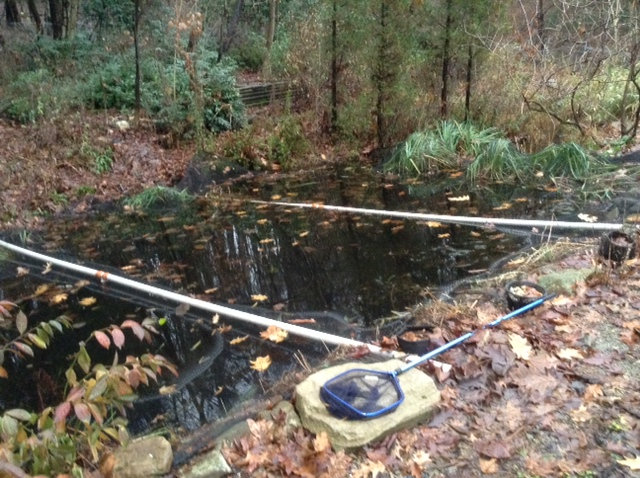
Pond cleaned and netted
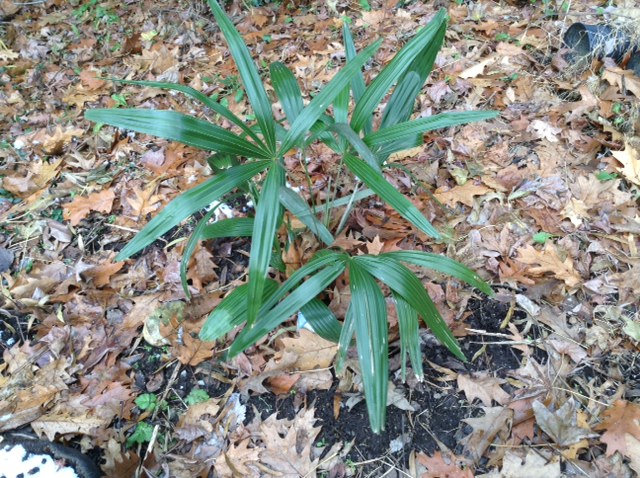
My sole surviving Needle Palm—Rapidophyllum hystrix on the approach to
the pond site.
This species which is marginally hardy in my landscape in a good microclimate and or active measures to cover and protect them during severe cold snaps is native to northern Florida and a spotty distribution in the Deep South. It had a more continuous range in that area and parts farther north before and during the Ice Age. That pattern is similar to the fossil records of the uncanny remains of the mixed northern and southern reptilian faunas noted in the J. A. Holman publication linked above.
Here is a horticulturally oriented article on this species which is essentially a warm / temperate climate palm with information on its natural history and cultivation in marginal climates: http://dctropics.blogspot.com/2015/02/needle-palms-big-bigger-biggest.html
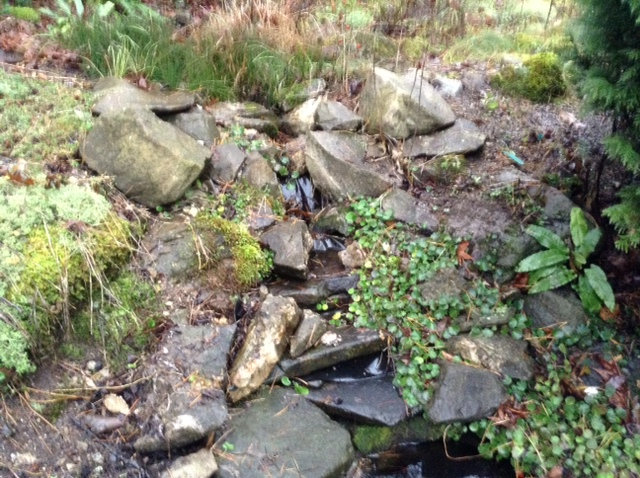
Before.
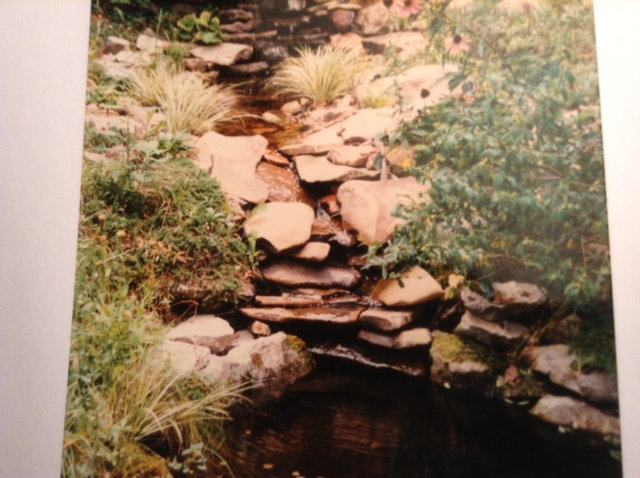
And after.
Actually before. The upper picture shows the falls above the Rosyside Pool as it is now and the lower one shows it not long after I finished the watercourse circa 1997. It looked much better then but I had to take it apart to do some adjustments and liner repair and was not able to figure our how to put it back together the same way again.
I'm hoping to use these photos to combine the best of both with more emphasis on the original version. Will have to relocate all the original stones—some of which got scattered and repurposed elsewhere in the landscape.
Another aim will be to thin some of the ground cover of Formosan Saxifrage and other plants that have become a bit excessive and overwhelming the stonework that made the original watercourse and surrounding rock garden more appealing to the eye.
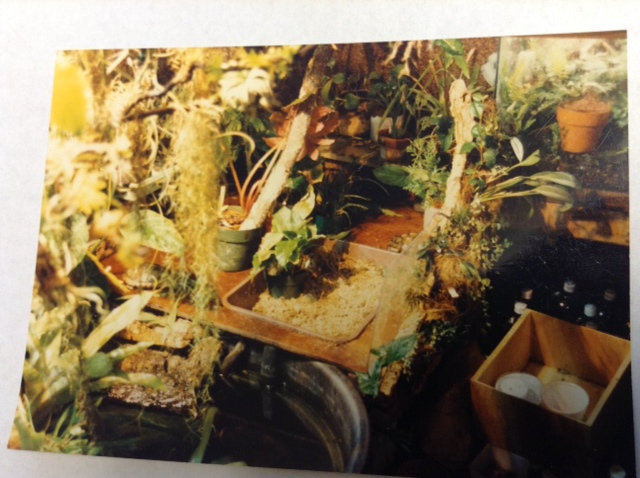
Photo of the Turtle Table setup in the Florida Room circa 1995. Poor
quality but it gives a good idea what once was and might be again.
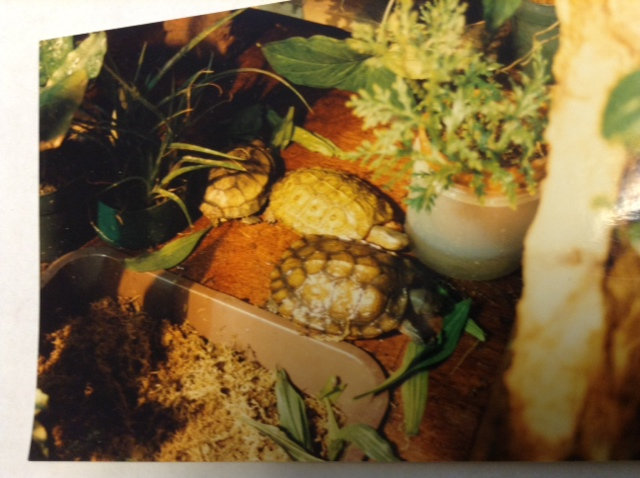
Close up of the occupants—a mixed group of three Rhinoclemmys
pulcherrima incisa (the Honduran Wood Turtle) two Rhinoclemmys areolata (the
Furrowed or Belize Wood Turtle of Yucatan and adjoining Guatemala and
Belize) and a single Rhinoclemmys pulcherrima pulcherrima (the nominate
subspecies from Guerrero)—one representative of each is chowing down on
plantain weed and dandelion leaves! From left to right—Belize , Guerrero and
Honduran.
Those were the days!
Was that worth reading?
Then why not:
![]()
AFFILIATE/ADVERTISEMENT
This site may receive compensation if a product is purchased
through one of our partner or affiliate referral links. You
already know that, of course, but this is part of the FTC Disclosure
Policy
found here. (Warning: this is a 2,359,896-byte 53-page PDF file!)
